
Jupiter’s tiny moon Amalthea captured by the Juno spacecraft
During its 59th close flyby of Jupiter on March 7, 2024, NASA’s Juno mission captured breathtaking views of the giant planet’s colorful belts and swirling storms, including the iconic Great Red Spot. However, upon closer examination, the images revealed something more: two glimpses of the tiny moon Amalthea.
Amalthea, discovered by Edward Emerson Barnard in 1892, was the last planetary satellite to be found by direct visual observation.
Named after the mythical goat who nursed the infant Zeus in Greek mythology, Amalthea is the largest of Jupiter’s inner moons and the fifth-largest moon overall.
Amalthea’s unique characteristics
With dimensions of 250 × 146 × 128 kilometers, Amalthea has an irregular shape and a low average density of around 0.85 g/cm³, indicating that it is composed mostly of ice with a small fraction of rock.
Orbiting Jupiter at a distance of approximately 181,400 kilometers, Amalthea completes one orbit around the gas giant in just under 12 hours.
Interestingly, Amalthea is the reddest object in the solar system and gives out more heat than it receives from the Sun.
This phenomenon may be due to electric currents induced in the moon’s core as it orbits within Jupiter’s powerful magnetic field, or it could be caused by tidal stresses from Jupiter’s gravity.
How Jupiter’s moon Amalthea influences its ring system
Amalthea’s orbit lies within Jupiter’s main ring system, and the moon is thought to be a significant contributor to the ring’s dust content.
Its surface is heavily cratered, with the largest crater, Pan, measuring about 90 kilometers in diameter. The moon’s surface also features a number of bright patches, which are believed to be relatively fresh impact craters.
Galileo gets the first up-close view
The Galileo spacecraft provided the first detailed images of Amalthea during its mission to study the Jovian system from 1995 to 2003, revealing the moon’s irregular shape and heavily cratered surface.
Although no dedicated missions to Amalthea are currently planned, future missions to study the Jovian system may provide further insights into this intriguing inner moon.
At the time that the first of these two images was taken, the Juno spacecraft was about 165,000 miles (265,000 kilometers) above Jupiter’s cloud tops, at a latitude of about 5 degrees north of the equator.
Citizen scientist Gerald Eichstädt made these images using raw data from the JunoCam instrument, applying processing techniques to enhance the clarity of the images.
Amalthea and the significance of Jupiter’s inner moons
Jupiter’s inner moons, including Amalthea, are important for several reasons:
Understanding the formation and evolution of the Jovian system
Studying the inner moons can provide insights into how they formed and evolved alongside Jupiter, offering clues about the early history of our solar system.
Influence on Jupiter’s ring system
The inner moons, particularly Amalthea, are thought to be significant contributors to the dust content in Jupiter’s ring system. Investigating their role in shaping and maintaining the rings can help us better understand the dynamics of planetary ring systems.
Unique physical properties
Jupiter’s inner moons exhibit unusual characteristics, such as Amalthea’s low density and high heat output. Exploring these properties can help scientists develop new theories about the composition and internal structure of small, irregular moons.
Tidal forces and orbital resonances
The inner moons are subjected to strong tidal forces from Jupiter and may also interact with each other through orbital resonances. Studying these interactions can provide valuable information about the complex gravitational dance within the Jovian system.
Amalthea: Tiny moon with a big impact
In summary, the Juno mission’s serendipitous capture of Amalthea during its 59th flyby of Jupiter has provided us with a tantalizing glimpse into the fascinating world of this tiny, yet influential moon.
As we continue to explore the Jovian system, we eagerly anticipate the discoveries that future missions and citizen scientists will uncover, further unraveling the mysteries surrounding Amalthea and its role in shaping Jupiter’s complex environment.
Through these endeavors, we will undoubtedly deepen our understanding of not only this mythical moon but also the intricate dynamics at play within our solar system’s largest and most captivating planetary system.
JunoCam’s raw images are available for the public to peruse and process into image products.
More information about NASA citizen science can be found here.
—–
Like what you read? Subscribe to our newsletter for engaging articles, exclusive content, and the latest updates.
Check us out on EarthSnap, a free app brought to you by Eric Ralls and Earth.com.
—–













